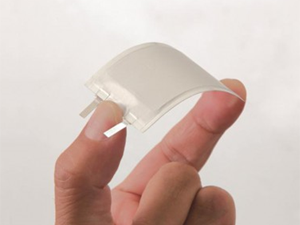



Date:30/09/16
 Panasonic Corporation presented its new development – a flexible lithium-ion battery. Battery thickness is about 0.55 mm. the Battery is suitable for use in Wearables: smartwatches, fitness bracelets, smart clothing and other devices.
Panasonic Corporation presented its new development – a flexible lithium-ion battery. Battery thickness is about 0.55 mm. the Battery is suitable for use in Wearables: smartwatches, fitness bracelets, smart clothing and other devices.
The battery recharges and maintains its performance after repeated bending (radius up to 25 mm) and twisting (25 degrees on its axis). This is the main advantage of a novelty: unlike traditional lithium-ion batteries, this battery is not deformed and thus does not break when bend.
Such properties were achieved by radically new internal structure of the battery using a laminated outer layer. According to Panasonic, the flexible battery retains up to 99% of its original capacity after thousands of consecutive flexion or turning. However, as indicated above, the maximum allowable bending radius is 25 mm, and the angle – 25 degrees.
In addition, the battery is securely protected from leaks and heating that allows its use in devices in close proximity with the human body (hence the possibility of integration with wearable gadgets and “smart” clothing). The development is protected with 25 patents in Japan and 15 international patents, counting claims.
Panasonic will show the new product in the near future at the international exhibition CEATEC 2016, which will be held from 4 to 7 October in Japan.
Delivery of the first samples of flexible battery is scheduled for late October of this year. Meanwhile, Panasonic will work to further reduce the thickness of the batteries, so they can be used in even more wearable and IoT devices.
Panasonic has developed a flexible lithium-ion battery for smart clothing and wearable devices
 Panasonic Corporation presented its new development – a flexible lithium-ion battery. Battery thickness is about 0.55 mm. the Battery is suitable for use in Wearables: smartwatches, fitness bracelets, smart clothing and other devices.
Panasonic Corporation presented its new development – a flexible lithium-ion battery. Battery thickness is about 0.55 mm. the Battery is suitable for use in Wearables: smartwatches, fitness bracelets, smart clothing and other devices.The battery recharges and maintains its performance after repeated bending (radius up to 25 mm) and twisting (25 degrees on its axis). This is the main advantage of a novelty: unlike traditional lithium-ion batteries, this battery is not deformed and thus does not break when bend.
Such properties were achieved by radically new internal structure of the battery using a laminated outer layer. According to Panasonic, the flexible battery retains up to 99% of its original capacity after thousands of consecutive flexion or turning. However, as indicated above, the maximum allowable bending radius is 25 mm, and the angle – 25 degrees.
In addition, the battery is securely protected from leaks and heating that allows its use in devices in close proximity with the human body (hence the possibility of integration with wearable gadgets and “smart” clothing). The development is protected with 25 patents in Japan and 15 international patents, counting claims.
Panasonic will show the new product in the near future at the international exhibition CEATEC 2016, which will be held from 4 to 7 October in Japan.
Delivery of the first samples of flexible battery is scheduled for late October of this year. Meanwhile, Panasonic will work to further reduce the thickness of the batteries, so they can be used in even more wearable and IoT devices.
Views: 583
©ictnews.az. All rights reserved.Similar news
- The mobile sector continues its lead
- Facebook counted 600 million active users
- Cell phone testing laboratory is planned to be built in Azerbaijan
- Tablets and riders outfitted quickly with 3G/4G modems
- The number of digital TV channels will double to 24 units
- Tax proposal in China gets massive online feedback
- Malaysia to implement biometric system at all entry points
- Korea to build Green Technology Centre
- Cisco Poised to Help China Keep an Eye on Its Citizens
- 3G speed in Azerbaijan is higher than in UK
- Government of Canada Announces Investment in Green Innovation for Canada
- Electric cars in Azerbaijan
- Dominican Republic Govt Issues Cashless Benefits
- Spain raises €1.65bn from spectrum auction
- Camden Council boosts mobile security





















